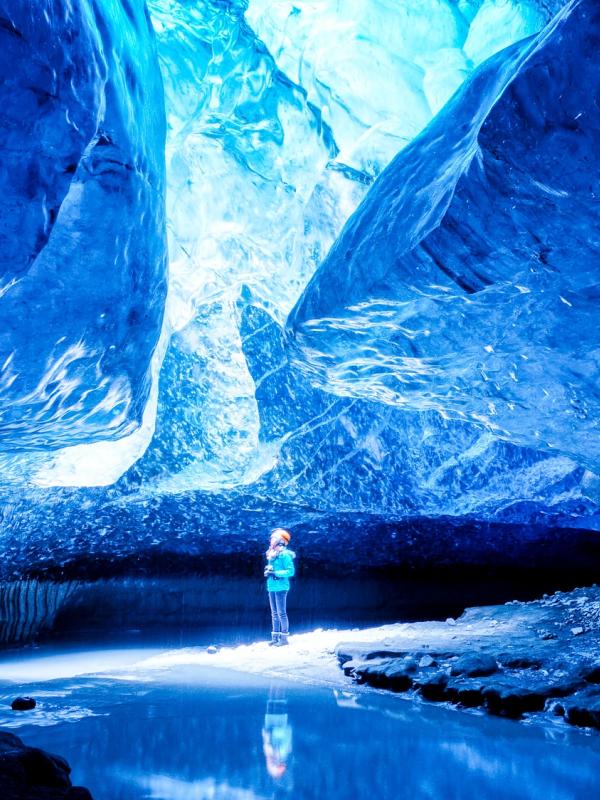
Ice Caves in Iceland: A Full Guide For Adventurers
Iceland is a country characterized by stark contrasts. It has been nicknamed the “Land of Ice and Fire,” and not only because it sounds cool. The powerful forces of the Earth have shaped this country dramatically, creating astonishing landscapes in the process. The part of the fire comes from the intense volcanic activity present on the island. The other half, the ice, is mainly present in the numerous glaciers in Iceland. These icy giants have been key in the formation of the country, and they have also had an impact on the local lifestyle.
And inside the glaciers, we can find ice caves. They are surreal creations that seem straight out of a fantasy novel. These unique formations are part of Iceland’s dynamic landscapes, and their beauty is complex. In this guide, we’ll walk you through everything you need to know about exploring Iceland’s ice caves: how they form, where to find them, when to visit, and how to prepare for this extraordinary adventure.
Key Takeaways
- The ice caves are formed normally inside the glaciers, when meltwater freezes again to create unique tunnels and formations.
- This process is a cycle and new ice caves are created every winter.
- Visiting ice caves should be done with an expert guide, both for educational and safety purposes.
Glaciers in Iceland
To fully appreciate and understand ice caves, it’s good to know how important glaciers are in Iceland. They are, first of all, among the most present features of Iceland’s landscape, covering about 11% of the country. These massive, slow-moving rivers of ice are formed over thousands of years, with layers of snow compressing into dense ice. The process begins when snow accumulates in a particular area, such as a mountain range, which doesn't fully melt in summer. Over time, the weight of new snow compacts the older layers below, gradually transforming them into solid ice.
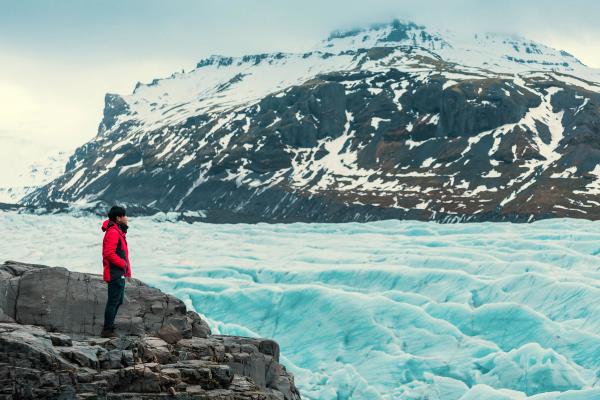
How Are Ice Caves Formed?
The formation of ice caves is a delicate and fascinating process. It’s the result of the combination of water, temperature, and time. There are thousands of intricate systems of meltwater channels underneath Iceland’s massive glaciers. Under the right conditions, they transform into the mesmerizing ice caves that we can visit.
During the warmer summer months, the surface of a glacier begins to melt as temperatures rise. In Iceland, this usually happens between late May and mid-September. This water makes its way down into the glacier through cracks and crevices, creating small rivers that make their way through the dense ice. These rivers carve out tunnels and chambers over time, creating the early stages of an ice cave. As the water flows, it carries with it sediment and minerals, shaping the glacier’s interior into unique forms.
When winter arrives, and temperatures drop, meltwater flow decreases, and the channels begin to freeze. It’s during this freezing process that the tunnels that had been sculpted in the previous months harden into solid ice, becoming the stunning caves that can be found in several places in Iceland. However, because glaciers are constantly moving and changing, the caves are never the same from year to year. Old caves collapse, and new ones form. For this reason, each visit to an ice cave in Iceland is different and a one-of-a-kind experience.

Why Is The Ice in Some Caves So Blue?
Ice in some caves looks bright blue because the ice is very dense. Snow piles up on glaciers and never fully melts, so the weight of new snow squashes out air bubbles in the older layers. This dense ice absorbs most colors of light but reflects blue. The thicker and denser the ice, the deeper the shade of blue. In some places, the ice looks almost like a sapphire, especially under direct sunlight or when illuminated by a flashlight. Newer, less dense ice usually looks white. In some Icelandic caves, black streaks in the ice come from volcanic ash—a result of nearby volcanic eruptions. These details make each ice cave unique.
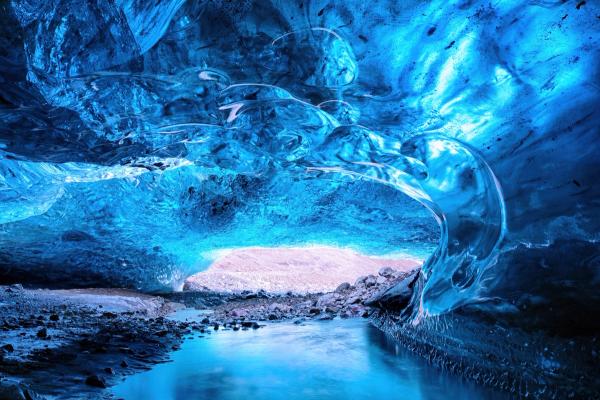
Where Are the Ice Caves in Iceland Located?
As we said, Iceland is home to several glaciers, many of which have ice caves. The most accessible and popular ice caves are located in the southern part of the country. Here are the key glaciers where you can find ice caves:
- Vatnajökull Glacier: Probably the best place in Iceland for ice exploration. This huge glacier, the largest in Europe, covers around 8% of the country’s landmass. In it, we can find some of the most famous caves, like the Crystal Cave and Sapphire Ice Cave.
- Mýrdalsjökull Glacier: Situated on Iceland’s south coast, this glacier sits above the active Katla volcano. It’s known for caves featuring layers of volcanic ash embedded in the ice, creating dramatic patterns.
- Langjökull Glacier: This glacier is located in western Iceland. Langjökull is home to a man-made ice tunnel that allows visitors to explore deep inside the glacier year-round.
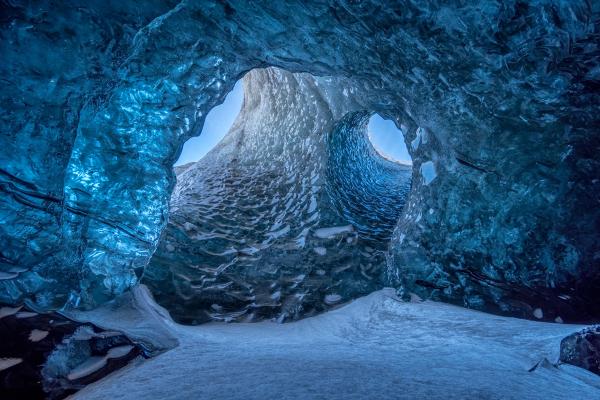
The Best Ice Caves in Iceland
One of the best things about ice caves in Iceland is that they are all different. Even from year to year, the same cave can have a quite different look, so not every visit is the same. Here are some of the most iconic ice caves you can explore:
The Crystal Ice Cave
This is perhaps the most famous ice cave in Iceland, known for its bright, shiny blue ice and vast and tall inner chambers. It’s like a cathedral made of ice. It’s located inside Vatnajökull Glacier, and the natural wonder attracts thousands of visitors every year, especially photographers looking to capture its beauty, which seems straight out of a science fiction movie. The cave’s appearance changes annually as the glacier's movement reshapes it. Winter is the ideal time to visit when colder temperatures make the structure more stable and safer.
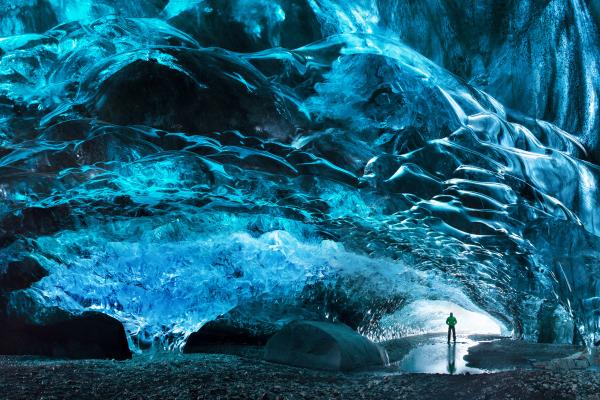
Katla Ice Cave
The Katla Ice Cave, located beneath the Mýrdalsjökull Glacier, offers a striking contrast of blue ice and black volcanic ash. This combination creates amazing patterns that are the perfect example of the constant interaction between ice and fire that happens in Iceland. Unlike many other ice caves, Katla is accessible all year, thanks to its stable conditions. The cave is quite near the active Katla volcano. Tours to the Katla Ice Cave often depart from Vík. This town can be a functional base if you are exploring not only the caves in South Iceland but also the region in general.
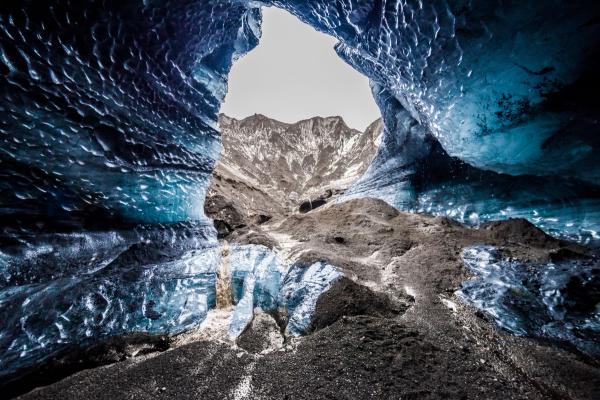
Sapphire Ice Cave
Named for its intensely deep blue ice, the Sapphire Ice Cave is another gem within the Vatnajökull Glacier. This cave has walls with beautiful textures, and its smaller size (compared to the larger Crystal Ice Cave) allows you to see everything more in detail. The different shades of blue here shine on sunny days, and it’s perfect for those seeking a quieter, less crowded experience. As happens with other ice caves in Vatnajökull, it is accessible only during winter when the ice solidifies.
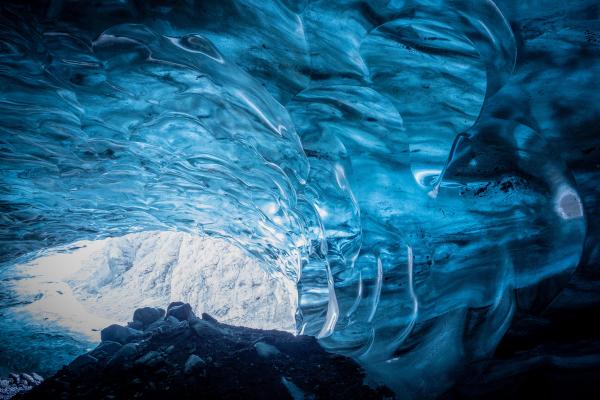
Langjökull Glacier Ice Tunnel
Unlike natural ice caves, the Langjökull Ice Tunnel is entirely man-made. It’s been carved in Iceland's second-largest glacier, which gives its name to the tunnel. One of the best things about this place is that it can be visited in the four seasons. There’s a guided tour that takes visitors deep into the ice. The guides will explain the glacier’s structure, its history, and the impact that climate change has on these ice giants. The tunnel has a series of chambers and even an ice chapel, making it a unique experience compared to natural caves. It’s perfect for summer travelers who can’t visit those ice caves that are only accessible in winter.
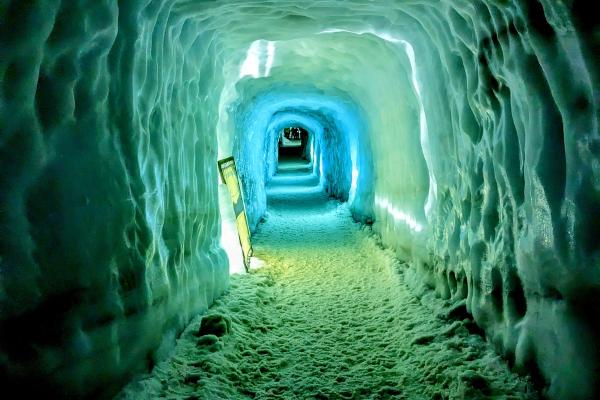
Skaftafell Ice Cave
The Skaftafell Ice Cave is a lesser-known gem located in the Skaftafell Nature Reserve, which is part of Vatnajökull National Park. It’s famous for its smooth, reflective walls that look like glass. It’s accessible only in winter, and this cave offers a more secluded experience compared to the Crystal or Sapphire caves. A great option is to combine a tour of Skaftafell Ice Cave with hikes in the nature reserve, known for its striking landscapes and waterfalls.
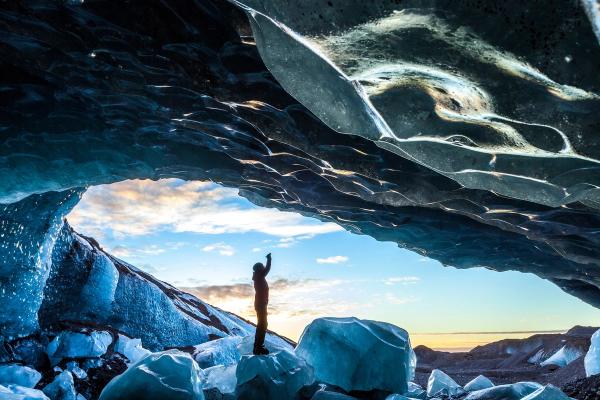
Lofthellir Ice Cave
We now go to North Iceland to discover another great ice cave. Lofthellir is located near Lake Mývatn, and it’s quite different from other ice caves on this list. It’s, in fact, a lava tube filled with old ice formations, and a different look into a world where fire and ice coexist. The cave’s interior features stalactites, stalagmites, and other frozen sculptures that have formed over thousands of years. Unlike most of the glacier ice caves, Lofthellir remains accessible throughout the year, making it a must-visit for travelers exploring the north. Due to its remote location, there are not as many tours available as in other places.
Guided Tours in Ice Caves
Visiting an ice cave is not something that you should do on your own. The caves are part of a constantly shifting landscape, and navigating them requires specialized knowledge and equipment. Guided tours are essential to have both safety and an enjoyable experience.
Tour operators provide everything you need to explore the caves, including helmets, crampons, and proper footwear. They also monitor conditions daily to ensure the caves are safe for visitors. Apart from safety, guides also offer fascinating facts and data about the formation of the caves, the history of the glaciers, and the surrounding environment. They know the best spots for photos and can point out unique features you would probably miss.
There are tours with different lengths and difficulty levels, going from short walks suitable for beginners to longer treks for those searching for an adventure. Most tours depart from towns or cities, like Reykjavik or Vík, or famous natural places, such as Jökulsárlón. They are very easy to incorporate into your Iceland itinerary.
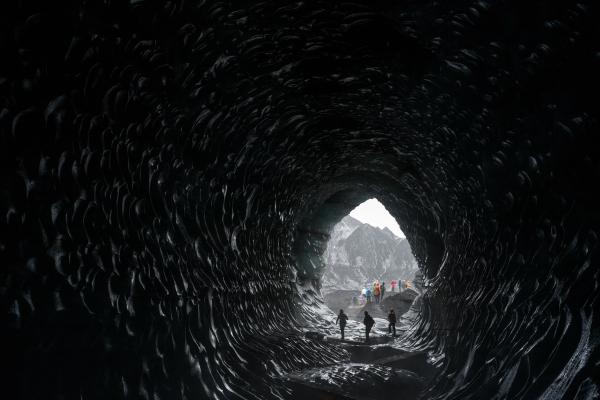
The Ice Caves in Different Seasons
Ice caves, like the glaciers that contain them, are dynamic, and their appearance and accessibility change with the seasons. Most of them are only accessible in the colder months, while others can be visited all year round.
Here’s what you can expect throughout the year:
Winter (November to March)
Winter is the peak season for ice cave exploration. During these months, the colder temperatures make the caves stable, so they are safe to visit. The blue shades of the ice are at their most vivid due to the absence of direct sunlight. This is also when most natural caves, such as the ones in Vatnajökull, are accessible.
Spring (April and May)
As temperatures begin to rise in spring, the glaciers start to melt. Many natural ice caves become unstable and unsafe to enter. On the other hand, this is a great time to see the glaciers’ surface melting and witness the early stages of the cave formation process.
Summer (June to August)
This is peak season in Iceland, but not a great time to visit ice caves, as most natural caves are inaccessible. However, some tours to Katla Ice Cave remain available, as it is less affected by seasonal changes. Additionally, the man-made tunnels in Langjökull are open. This way, if you are coming in summer, you still have the opportunity to visit some of these frozen structures.
Autumn (September and October)
Autumn marks the beginning of ice cave season when temperatures begin to drop. The guides start scouting the caves, and by late October, some natural caves may be safe for exploration. This transitional period usually has smaller crowds and a chance to see freshly formed caves.
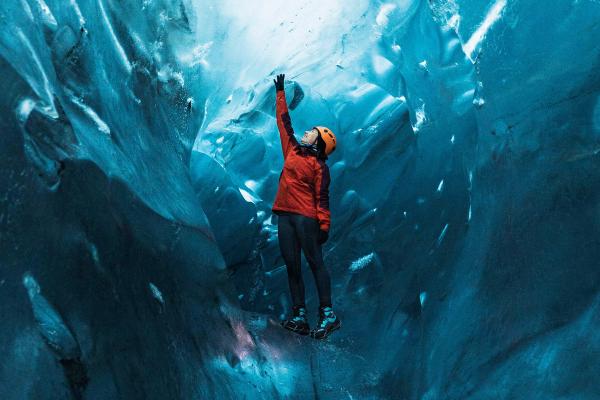
Tips for Visiting the Ice Caves
Visiting an ice cave is an unforgettable experience, but proper preparation is essential. Here’s what you need to know:
- Book early: Ice cave tours are incredibly popular, especially during winter. Many of them fill up fast, so it’s better to secure your spot well in advance to avoid disappointment.
- Dress warmly: As you can imagine, it’s quite cold inside an ice cave. Dress in layers to adjust to the different temperatures you can experience throughout the day. Use thermal underwear, insulated jackets, waterproof pants, and gloves. Don’t forget a hat that covers your ears.
- Wear proper footwear: Sturdy, waterproof hiking boots are essential. Tours typically provide crampons to help you walk on the ice, but you’ll need boots with good ankle support when you’re not actually walking on ice.
- Bring a camera: The ice caves are a photographer’s paradise. If possible, use a camera that performs well with little natural light. A tripod can also help.
- Stay flexible: Weather conditions in Iceland change rapidly and are unpredictable. Tours may be canceled or rescheduled due to safety issues, so have some flexibility in your itinerary.
- Listen to your guide: Safety is extremely important in ice caves. Always follow your guide’s instructions and never wander off on your own.
Conclusion
Visiting the ice caves in Iceland is a magnificent experience. They are a breathtaking reminder of the beauty and power of nature. They come in all shapes and sizes, and they change every year to create new, astonishing formations. Most of them are accessible only in winter, but you can still get inside some of them the rest of the year. And, naturally, each cave offers a unique experience.
Just plan ahead, dress appropriately, and choose a guided tour. The textures and colors you’ll see inside these ice marvels will do the rest.


